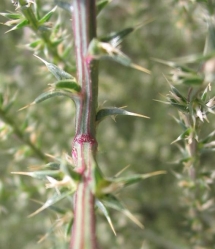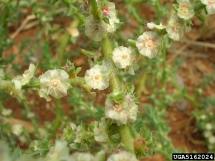Overview
Commonly known as tumbleweed, Russian Thistle prefers sandy, saline soil which has resulted in a strong presence of this invasive species along stretches of sandy, semiarid regions. Russian thistle is especially invasive in disturbed regions, such as in agricultural land or along stream banks, making revegetation and monitoring work critical to ensure that this weed does not re-establish itself in restored watersheds.
Origin
Recent research has differentiated the different species found in California and the place of origin, ranging from Ukraine to South Africa as well as a stretch from southern Russia to Mongolia and China. The two most common species in coastal California regions, Salsola tragus and S. kali, originate from southern Ukraine and South Africa respectively. Identifying the species is key for appropriate biological control, especially since current control methods are not producing ideal results.
Ecological Effects
Russian thistle poses a hazard due to its role as a weed and host for pests in restored and agricultural areas, decreasing production of native vegetation and desired crops such as tomato and beet. For livestock, the weed also creates a risk of bioaccumulation of oxalate toxins for animals such as sheep that feed on it. Traffic hazards and removal costs arise from the accumulation of dried plant matter once the plant dies, especially in fallow fields or irrigation systems, as well as the sides of roadways. Further decreases in crop yield and increases in fire risk also result from this accumulation. In natural systems, it establishes in disturbed sites, particularly in sandy soils and where mechanical treatments for other weeds facilitate its infestation, and subsequently competes with recruitment of native plants, provides little habiat for wildlife, while the dense growths create a continuous fuelbed that can carry wildfire.
Biological Control
Research elsewhere in the state has focused on understanding and identifying this genetic diversity in order to distinguish appropriate biological control methods. Biological control agents such as mites and weevils from the respective native regions of each particular species are increasingly being studied as effective control measures. Visit Publications for resources from the RiVRLab and elsewhere related to this information.


 Detail
Detail Russian thistle flowers (Forest & Kim Starr, U.S. Geological Survey, Bugwood.org)
Russian thistle flowers (Forest & Kim Starr, U.S. Geological Survey, Bugwood.org)